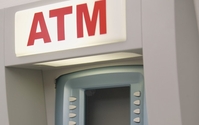Commentary
What, You Still Use a Plastic Card to Get Cash from an ATM?
- by Chuck Martin , Staff Writer, January 23, 2014
 Getting cash from an ATM is moving to the smartphone as the
gradual move to cardless cash continues.
Getting cash from an ATM is moving to the smartphone as the
gradual move to cardless cash continues.
For all the buzz about connected cars, M2M (machine-to-machine) activity, the IoT (Internet of Things) and basically the interconnectedness of various physical devices accessed through the net and other current concepts, especially at the recent CES International show, it looks like many machines will first be connected to the smartphones of consumers.
While the machine interconnection permutations continue to evolve and advance, the smartphone continues to move even more to center stage for normal commerce-related things that consumers do day-to-day.
Some of the automated machines are essentially being extended out to smartphones.
The activity moving to smartphones is not necessarily replacing but more augmenting current consumer tasks, moving more of the initiating action to the phone.
One of the simplest examples is using a smartphone to change channels on a TV. Transitioning into commerce, at CES I watched a shopping demo on Samsung’s Smart TV that enables a viewer to text a purchase option to a phone.
At the recent National Retail Federation Expo in New York, Gilbarco Veeder-Root, the world’s largest manufacturer of gas pumps, showed a gas pump with built-in sensors that identifies a nearby consumer getting ready for a fill-up (Gas Pump of the Future Sees You Coming), expected to be deployed in the U.S. this year.
What struck me more than the ability to recognize the consumer is what happens after. The act of entering information into the gas pump, such as a credit card swipe and octane selection, is being transferred to the smartphone.
This same activity is now starting to happen at ATMs, courtesy of Paydiant.
Most people have never heard of Paydiant, and likely won’t, since the mobile payment system is always white labeled so that it runs inside of someone else’s brand, as we wrote about here last summer (The Mobile Wallets Flying Under the Radar).
The company announced today that it has received a patent for a certain approach for using a mobile device to conduct transactions at ATMs to get cash.
The consumer enters the amount required on their phone, scans the QR code displayed on the ATM and out comes the cash.
The key here is that the consumer manipulation of the mechanical device is moving to the smartphone, essentially augmenting the activity of the ATM.
Rather than reaching out and touching keys or swiping or inserting a card at the physical machine, the activity is becoming more up close and personal, managed on the consumer’s smartphone.
“It’s more convenient and more secure,” said Chris Gardner, co-founder of Boston-based Paydiant. “Banks are struggling with how to play in the mobile payment space.”
The cardless cash system has been rolling out to customers at Wintrust Financial banks and City National Bank along with companies that provide bank technology, including FIS and Diebold.
“Banks are looking for these sticky services,” said Gardner. “The phone will be the fundamental tool in transactions.”
The Paydiant system is also used outside of banks, such as for making payments in the Subway app (Subway Adding Mobile payments to the Menu).
Whether buying from TV, pumping gas or getting cash from an ATM, consumers are being introduced to new ways to integrate their phone usage into things they already do in an attempt to increase efficiency.
Welcome to the age of Augmented Machines (AM). Courtesy of the smartphone.




I've been wondering when this was going to happen. Looks like an opportunity (or should I say "Apportunity")for IAD's to upgrade equipment. Wonder how long it's going to take for free standing ATM manufacturer's like Triton, Hyosung, Hantle, and Genmega to offer models with a bar code scanner reader. We'll certainly be watching how this unfolds.
Noah Wieder, CEO
ATMDepot.com
Good point, Noah, but in this case it is my understanding that all is done in software, so no hardware modifications need to be made. The code is simply displayed on the ATM and then read by the smartphone app, triggering the transaction.
Never ever keep all of your information and financial abilities in one place. Hard way to learn a lesson to. Harder to find when you need to.
Re: "The act of entering information into the gas pump, such as a credit card swipe and octane selection, is being transferred to the smartphone." I use one phone but drive both a diesel and a petrol car, so I very much hope this is not true! If you must automate how fuel is selected, let the pump recognize the car, e.g. by having a bar code on the filler cap.
Thanks for the comment Pete, but the consumer still could use the button on the gas pump to assure the correct fuel is selected.
Hi Chuck,
Interesting. I'll have to read up on that. I don't see how the ATM would initiate the transaction without the card or the phone starting the process. As it is now you must swipe your card to begin the transaction.
If the phone has the card or bank info in the app I would assume the ATM would need the bar code scanner to read the code on the phone to begin the transaction.
If the ATM had to begin the transaction as it stands without any new hardware, you are limited to keyboard or dip reader entry points.
Not sure how the ATM would know what code to show on the screen without some input first?
I guess more shall be revealed and it could be a few years away.
Noah Wieder
Atmdepot.com